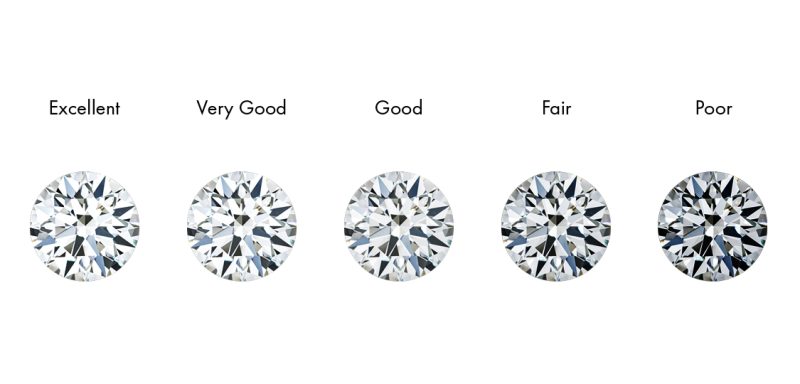Ever wonder what makes a diamond truly sparkle? While all 4 Cs matter, the Cut is king! I’m Certified Gem Knowledge, and today we’ll explore how a diamond’s cut unlocks its dazzling beauty, looking at the GIA scale and what creates that mesmerizing light show.
Understanding the GIA Diamond Cut Grading Scale
First things first: diamond cut isn’t about the shape (like round or oval). Instead, diamond cut refers to its proportions, symmetry, and polish. These factors determine how well a diamond handles light. To standardize this, the Gemological Institute of America (GIA) developed its Cut Grading System. The GIA scale grades round brilliant cut quality. Yes, the full GIA Cut Scale with its range from Excellent-Poor primarily applies to the most popular shape, the Round Brilliant Diamond.
Defining the Grades: Excellent, Very Good, Good, Fair, Poor
The GIA Cut Scale has five grades:
- Excellent (EX): The best of the best. An Excellent Cut offers optimal light performance. These diamonds display incredible brilliance, fire, and scintillation. They maximize light return beautifully.
- Very Good (VG): These diamonds still show exceptional sparkle, perhaps just slightly less intense than Excellent. They represent great beauty and are a very popular choice.
- Good (G): A Good cut reflects most light well. The diamond will still be beautiful, but might lack some of the vibrancy of the top two grades, potentially appearing a bit duller.
- Fair (F) & Poor (P): Diamonds in these categories don’t interact well with light. A Poor Cut results in low light performance and significant light leakage, making the diamond appear dark, lifeless, and lacking sparkle. Poorly cut diamonds appear dull or dark.

How Diamond Cut Creates Dazzling Sparkle
So, how does cut actually make a diamond sparkle? It’s all about Light Performance. Diamond cut determines light performance. When light enters a diamond, the quality of the cut dictates how it travels inside and reflects back to your eye. Light interacts with diamond facets. This creates three dazzling effects:
Brilliance
Brilliance is white light reflection. It’s the overall brightness you see coming from the diamond. A well-cut diamond acts like a collection of tiny mirrors, bouncing white light around internally and sending it back out the top.
Fire
Fire is dispersion of light into colors. As white light passes through the diamond’s facets (acting like tiny prisms), it splits into spectral colors – those beautiful rainbow flashes. The diamond cut affects fire, and precise angles are needed to create this effect effectively.
Scintillation
Scintillation is the pattern of sparkle. It’s the combination of bright flashes (sparkle) and contrasting dark areas you see as the diamond, the light source, or you move. The diamond cut affects scintillation, creating that lively, dynamic flashing effect. This sparkle factor assessment is key to a diamond’s appeal. Achieving a high light performance rating requires mastering all three.
The Anatomy of a Diamond Cut: How Grades Are Determined
Grading diamond cut is a complex gemstone craftsmanship evaluation. Let’s look at the core elements:
Assessing Proportions
Proportions are critical. Proportions include table percentage and depth percentage. They also include crown angle and pavilion angle. These measurements dictate how light behaves inside the stone. Key proportions factors include:
- Table Percentage: The size of the top flat facet relative to the diamond’s width. The table percentage affects light entry.
- Depth Percentage: The diamond’s height from table to culet, relative to its width.
- Crown Angle: The angle of the top facets sloping down from the table. The crown angle affects fire and brightness.
- Pavilion Angle: The angle of the bottom facets sloping down to the point (culet). This heavily influences light return. The pavilion angle affects light return.
- Girdle Thickness: The thickness of the diamond’s outer edge. The girdle thickness relates to durability and weight ratio.
- Culet Size: The size of the tiny facet at the very bottom point. The culet size affects appearance (face-up).
Proportions influence brilliance and proportions influence fire. They are fundamental cut grading factors.
Evaluating Finish
Finish refers to the quality of the diamond’s surface and facet placement:
- Symmetry: How precisely the facets align and meet. Symmetry relates to the exactness of facet arrangement. Good symmetry affects the light reflection pattern, ensuring even sparkle. This is a key cut grading factor.
- Polish: The smoothness and quality of each facet’s surface. Polish describes the smoothness of facet surfaces. Excellent polish impacts surface smoothness allowing light to enter and exit cleanly. This is the final cut grading factor. Craftsmanship is assessed by polish and symmetry.
Why Cut is Often Considered the Most Important ‘C’
Among the 4 Cs, many experts agree: cut quality is crucial for diamond sparkle. While color and clarity are about the material itself, cut is about unleashing its potential. Cut is often considered the most important C for brilliance and overall beauty.
Why? A diamond with mediocre color and clarity but an Excellent Cut can look more stunning than a high-color, high-clarity diamond with a Poor cut. The excellent cut maximizes light return and beauty. Well-cut diamonds reflect light internally, creating that captivating dance. Poor cuts waste the diamond’s potential. This makes cut a major diamond value influence, as an excellent cut commands higher value.
Aiming for Optimal Sparkle
If maximum sparkle is your goal, understanding “ideal” proportions helps, especially for Round Brilliant Diamonds. While exact numbers vary slightly, aiming for light reflection optimization involves targeting ranges generally associated with Excellent GIA grades:
- Table Percentage: Often cited around 53% – 60%
- Depth Percentage: Often around 59% – 62.3%
- Crown Angle: Around 33.7° – 35.8°
- Pavilion Angle: Around 40.6° – 41.8°
Diamond Cut vs. Diamond Shape: Clearing the Confusion
It’s easy to mix these up, but the diamond shape distinction is important.
- Shape refers to the diamond’s outline – Round, Princess, Oval, Emerald, Pear, etc.
- Cut refers to the quality of its proportions, symmetry, and polish, which determines its light performance. The diamond shape differs from the diamond cut grade.
So, you can have a Round Brilliant shape with an Excellent cut, or a Round Brilliant shape with a Poor cut.
Conclusion
The cut truly brings a diamond to life! Prioritizing cut quality ensures you get the most sparkle and beauty. Thank you for reading this guide from Certified Gem Knowledge.


